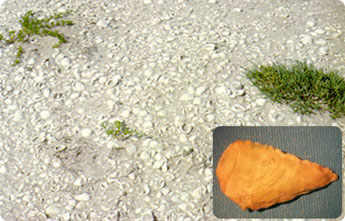Marine scientists often need expensive equipment to help them unlock the secrets of our watery world -- ships, diving gear, even satellites. But sometimes, what they really need is a good pair of shoes.
 Rangia cuneata clam shells (middens) found in Rincon Bayou, part of the Nueces River delta. Inset: single clam shell. Photo: Paul Montagna
Rangia cuneata clam shells (middens) found in Rincon Bayou, part of the Nueces River delta. Inset: single clam shell. Photo: Paul MontagnaConsider a project that scientists have dubbed “The Silence of the Clams.” It involves the estuary at the mouth of the Nueces River, along the Texas coast around Corpus Christi.
Like many urban areas, it’s undergone extensive development in recent decades. Highways and other big structures have dammed up parts of the river. So with little fresh water flowing in, much of the water in this estuary has become much saltier than the oceans -- about 5 to 10 percent salt.
Most people realized that the estuary was much less salty in earlier times, but they weren’t sure just how fresh the water was. But that information is critical for devising ways to help restore the estuary to a more pristine condition.
The answer was found in some ancient piles of clam shells.
As scientists examined the region on foot, they encountered big piles of shells. Anthropologists believe the piles built up when Indian tribes gathered for big ceremonial events hundreds of years ago.
The shells are from a species of clam that needs fairly fresh water to survive -- no more than one percent salt. That means the estuary had to be much fresher in the past. So the silent piles of clam shells -- discovered with the help of a little shoe leather -- have helped solve a mystery about a salty Texas estuary.
copyright 2006, The University of Texas Marine Science Institute

